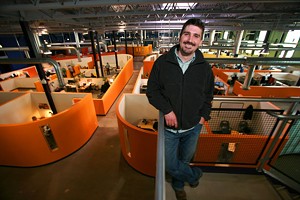Published January 23, 2008 at 2:34 p.m.
Vermont: land of maple syrup, milk, flatlander jokes and . . . software? You bet.
You don’t hear much about the state’s software companies — heck, the captive insurance industry gets more press — but there are now quite a few, and their numbers are growing.
In 2004, some of them banded together to start a trade organization, the Vermont Software Developers’ Alliance (vtSDA), which hired its first executive director in September. The vtSDA estimates there are at least 250 software companies in the Green Mountain State. Some have a single employee, some more than 100.
According to the vtSDA, the average salary at these companies is $60,000 a year. And many of them are looking for workers. In fact, most say they plan to double their workforce in the next few years.
Who’s buying this software? It’s not all going to the local market, that’s for sure. Each of these companies has found a niche, whether it’s supporting car dealers, supermarkets or elementary school teachers. Their clients do business all over the world. Vermont software is in service at military bases in Turkey and pediatricians’ offices in Arizona.
This week, Seven Days writers take a closer look at five of Vermont’s software developers to find out why they’re here, and how they found their markets.
*************************
*************************
Hard Drive: Dealer.com
You can order a latte online — without leaving the “pod” — and a barista from the in-house organic “dot calm cafe” will deliver it to your desk. Need to blow off a little steam after that last conference call? Play a game of ping-pong, or check out the fully equipped fitness center that overlooks an indoor tennis court. No sign of regulation dark green here: The court’s state-of-the-art surface is bright purple and blue.
Welcome to the corporate headquarters of Dealer.com, an industry leader in online auto marketing. Former Specialty Filaments workers wouldn’t recognize the new incarnation of the Pine Street plant in which they toiled, making bristles for toothbrushes and brooms, until 2005. The cavernous factory has been transformed into an aesthetically appealing hive of info-age industry that — with its orange-and-blue color scheme, giant beanbags and hip young staff — resembles a San Francisco start-up.
There’s one reason for Dealer.com’s Vermont license plate: Owner Mark Bonfigli got his start at Earthcars in Williston. There, he and his brother Andy experimented with early Internet strategies in pursuit of an unusual goal: to sell vehicles without using traditional salespeople. Mark developed a “little tool” that kept track of customers’ preferences and sent them an email when their dream car came in — kind of a primitive RSS feed.
In the mid-’90s, when email was still a novelty, “It was the right idea at the right time,” suggests Dean Evans, the company’s chief marketing officer. “He got a huge, first-mover advantage.”
Bonfigli didn’t stop there. Along with Mike Lane and three college buddies — Rick Gibbs, Jamie LaScolea and Ryan Dunn — he developed a suite of online marketing tools that include search-engine marketing, inventory management, lead tracking and website design. Dealers buy in on a monthly subscription basis, and in return receive ongoing training and consultation from Dealer.com. With virtually no up-front investment, even the smallest dealership can look up to speed.
Since it was founded nine years ago, Dealer.com has launched more than 4000 integrated web-based marketing packages for dealerships. Some are small, stand-alone operations. Others are large groups. Bonfigli estimates between 40 and 50 percent of Vermont’s car sellers work with his company; Greensboro Garage was the first local taker.
“Customers may not notice, but there’s been a massive change in the paradigm,” says Bonfigli. “It’s not ‘Let’s go send you off to another Auto Trader, where there are a million and a half cars to look at.’ Instead, you’re on Google, and you want a Subaru Legacy wagon at a certain price range, and it sends you straight into the inventory that has it. We were the first company to integrate Google in that regard.”
The innovation continues. A book titled Marketing to the Social Web rests on the desk in Evans’ second-floor office, which overlooks the “shop floor.” But, with potted wheat grass on the windowsill and a throw rug made of leather strips, it looks more like a boutique hotel room than Car-Sales Central. Evans speaks from experience when he claims most dealerships still spend the bulk of their marketing dollars on print ads: His long auto-industry resumé includes two and a half years managing a Chrysler dealership in San Francisco. He estimates about 10 percent of the auto-advertising pie currently goes to Internet marketing, and says 30 percent would represent a “healthier balance.”
Dealer.com is counting on that positive trend — the 110-employee company plans to hire another 100 people in the next year. Vermont HITEC trained the last big batch of new workers, mostly for account-management jobs. That local nonprofit also provides technical training for medical transcriptionists at Fletcher Allen — jobs that might otherwise have been outsourced.
“We have no plans to ever outsource anything,” Bonfigli vows. And it shows. A tour through the maze of creatively adorned workers passes plenty of empty cubicles in the pods that house the “software engineering,” “account management” and “search engine marketing” teams. The bright orange walls are low enough to see over, and strategically placed windows allow workers to gaze from one pod into another.
Evans says he left his last job — at Dealer.com’s number-one competitor — for one reason: corporate culture. “Here everyone wants to be a winner; everyone wants to be the best,” he observes. “It’s small enough, and the community is small enough, there’s a lot of ownership.” He has one complaint, though. Pushing 40 in a company where he estimates the median age is 29, “I feel old,” Evans laments. “I used to be the young guy.” Technology waits for no one.
*************************
*************************
Learning Curve: GlobalClassroom
If GlobalClassroom proves as successful as its founder envisions, the online learning center won’t only enrich Vermont’s high-tech sector — and the company’s associates — it will also transform the state’s image.
Five years from now, predicts Burr Warne, his fledgling firm will have grown from seven to 100 employees, and from $500,000 to $20 million in annual revenues. In addition, Warne says, “I want to brand Vermont as the education state.”
That may seem a grandiose vision for an Internet business currently operating from two small rooms, one of them windowless, in the basement of Farrell Hall on the former Trinity College campus in Burlington. But Warne, with his disarming smile and fluid logic, does make a convincing case.
Some 4000 teachers throughout the country have already taken professional-development courses through globalclassroom.us in the two and a half years since its launch. Several school districts, including two in Vermont, are making use of the company’s tech services and course content to develop online learning resources for elementary and high school students.
The growth rate for both the “teachers’ college” and the K-12 study programs has been “kind of viral,” Warne says. And he expects his site’s appeal to spread even more rapidly as growing numbers of grade-school teachers seek to integrate the Internet into their classrooms. “The challenge with K-8 teachers,” Warne says, “is to get them to make the time to try this approach. Once they do it, they see that their lives become much easier. Using our site is no harder than using a Word program.”
Teachers who tap into GlobalClassroom can communicate with students and parents in blog form and through posted assignments. Individually tailored lessons and reviews can also be delivered to home computers, thus eliminating the need, Warne suggests, for high schoolers to travel to locales where SAT prep courses are offered.
GlobalClassroom’s college courses for teachers are taught by professors at universities in several states. And the company’s online learning center is currently frequented mainly by K-12 teachers in Pennsylvania and Georgia, partly because its initial marketing efforts proved especially effective there, and also because Warne, 55, had earlier run another online education business from Atlanta.
But Vermont projects an image that can benefit a business such as GlobalClassroom, Warne says. Collaboration with respected local institutions including the University of Vermont, Middlebury College and St. Michael’s College can help his company grow while burnishing Vermont’s reputation for excellence in higher education, he adds.
Vermont’s association with learning was one reason Warne decided to move north, in 2005, with his wife, Lisa, and their three young children. “I can run my business from any place that has good Internet connections,” he points out.
Vermont has provided a nurturing home environment for Warne’s infant company. Its offices are leased from the Vermont Center for Emerging Technologies, a federally funded business incubator associated with UVM. The center also put Warne in touch with potential investors.
And contrary to what he was told by some tech entrepreneurs, Vermont has a broad pool of qualified prospective employees, Warne says. He notes that about a dozen Vermonters fluent in a particular programming language applied recently for openings with GlobalClassroom. He hired two of them.
But Warne says he’s no techie himself, despite two laptops on his desk. “I don’t build the sites,” he says. That’s the purview of his programmers, one of whom works from California and another from New York. But he does understand the online education market — which is why, Warne says, GlobalClassroom is likely to thrive.
The company’s main competitors, he notes, are the same school districts it is seeking to serve. Some superintendents think they can develop similar online resources in-house, but they find, Warne says, that such an option costs far more in terms of personnel and technical expertise than do the free or low-price services offered by his firm. “It takes us about an hour to put up a site,” he says, such as the one GlobalClassroom developed for the Burlington School District.
His company also competes with major universities in offering professional development courses to K-12 teachers. Surprisingly, however, only a few universities offer these credential-building courses online, Warne says.
As GlobalClassroom expands its reach in the United States, it will also start seeking opportunities abroad, probably focusing on China, according to Warne. In the meantime, he’s looking for a swankier location within the same zip code. He’s got one eye on the Pine Street silicon corridor, another on the world.
*************************
*************************
Aisle 2.0: MyWebGrocer.com
Grocery shopping has come a long way since farmers first gathered to offer their produce to the public. General stores selling hardware and kitchen staples by the pound have gone the way of the horse and buggy, and these days, even the mid-sized grocery store seems pretty old-fashioned next to Wal-Mart and Costco. The latter offers everything from tube socks to smoked salmon to caskets. How can a smaller grocery chain or an individual store compete?
By going online — at least, that’s the solution offered by a Colchester-based company called MyWebGrocer. Founded in 1999 by Rich Tarrant Jr., son of the former IDX head and 2006 senatorial candidate, MyWebGrocer supplies about 80 mid-sized grocery chains with a suite of web-based tools designed to increase customer loyalty, reduce hassle and encourage spending. The company’s hard-to-find office, filled with Dilbert-esque cubicles, is on the third floor of an office building on Mountain View Drive.
MyWebGrocer offers its clients email, circulars and recipe-management tools, but its most visible products are interfaces that allow customers to shop their local stores online. By synching up its inventory with MyWebGrocer’s database of more than 600,000 products — including health foods and organics — a store can offer web customers exactly what they would find on the shelves. Shoppers browse the virtual aisles to select their groceries — a quick click adds an item to a shopper’s cart — then choose a same-day delivery time or opt to sweep through the store’s “drive-thru.”
Right now, only 1 percent of Americans buy their groceries online, but MyWebGrocer VP Alec Newcomb expects that number to grow. “In the next five to six years,” he predicts, “you’ll probably go to 15 percent,” with that figure increasing to 30 or 40 percent 20 years from now. Why? Although shopping at a farmers’ market or a mom-and-pop can be “an experience worth having,” Newcomb suggests, the hassle of dealing with parking and lines isn’t worth it “when I’m just on a replenishment run.” Plus, more and more Americans live in areas that offer broadband Internet access. To keep pace, MWG has more than doubled in size — it now employs more than 40 staffers. Newcomb projects that staffing levels will double again in the near future.
Online sales aren’t just good for MWG, they’re good for the stores, says Newcomb. He claims that web-based buyers spend an average of 21 percent more than traditional shoppers, perhaps because they avoid the hassle of carrying groceries out to the car. Plus, “the grocery cart is a real, physical limitation” to buying capacity, he guesses.
MyWebGrocer survived the dotcom bust — the only business of its kind to do so. Newcomb says that’s because its offerings are extra-easy to use — crucial in a business where staffers may not be tech-savvy. As of today, 82 retailers nationwide — none in Vermont — pay monthly subscription fees to keep their 1400 stores linked in. When a new grocery chain comes on board, it takes about two weeks to get it up and running. “They connect to us in ‘the cloud,’” Newcomb says. “We host it, we run it, we worry about it.”
Employees at MyWebGrocer do need their share of tech-savvy: Newcomb says skills with programs like Photoshop are essential. Despite reaching out to students at the University of Vermont and Champlain College, he’s found it “very, very difficult” to recruit employees locally, he says.
Still, Newcomb says the company is “committed to being in Vermont. It’s part of our culture. We’re classic thrifty New Englanders.” And they claim to pass the wealth on to grocers: Once customers have saved their shopping lists on the web and gotten used to checking out sales during lunch break, they’re less likely to comparison shop. With MyWebGrocer’s help, Newcomb boasts, grocery stores “are getting back market share that they’d lost to other places.” Even mom and pop can appreciate that.
*************************
*************************
Computer Doctors: Physician’s Computer Company
Viruses are generally to be avoided in the computing world, but they helped launch Physician’s Computer Company (PCC). The Winooski firm got its start in 1982, when a local pediatric practice wanted to computerize its student immunization forms. Their medical software provider wouldn’t design a program for them; a nurse suggested that her son might be able to do it.
The docs hired 19-year-old John Canning and his friends, Jay Schuster and Ari Shinozaki, to create software that would track immunizations and computerize billing and scheduling. The college students finished the system during the summer of ’83. They went back to school and did customer support over the phone from their out-of-state dorm rooms: Canning at Rochester Polytechnic Institute; Schuster at Cornell; and Shinozaki at Princeton.
When other pediatricians began requesting their services, they realized they’d found a market.
Twenty-five years later, PCC is a nationally respected provider of pediatric practice management software. Nearly 200 practices with offices in 40 states use its “Partner” system. PCC now counts 42 full-time employees, including Canning and Schuster, and generates just under $5 million a year in revenue — not bad for a business that started out as a summer project for college students.
Chip Hart, PCC’s Pediatric Solutions Manager, explains that the company doesn’t have much competition in the pediatric software market. “It’s not a pond you would fish in,” he says. Pediatricians are poorly paid compared to other medical specialists, he continues. Most medical software companies — such as IDX — target hospitals and doctors who make more money.
Over the years, PCC has evolved to serve the needs of its niche market. In addition to developing software, PCC also sponsors conferences to train pediatricians to manage their practices more efficiently. Most pediatricians, after all, go into medicine to help kids, not to run a business. As medical billing becomes increasingly complex, these docs need skills that aren’t taught in medical school, and PCC helps provide them.
The company also does customer support. Hart estimates that PCC fields 1500 support calls a month. The issues range from “the printer paper is jammed,” to “our computer system is crashing.”
These are serious issues in any workplace, but even more so in offices where doctors are caring for sick kids. “We guarantee support 24/7, 365 days a year,” Hart proudly notes. “We’re the only people in this business who do that.”
Indeed, PCC has won several awards from KLAS, a national firm that evaluates medical software vendors — including one last year for receiving the highest customer rankings of any medical software vendor over the past decade.
These designations are based on customer reviews. The pediatricians who participate in KLAS surveys regularly give PCC very high marks.
New Jersey pediatrician Jill Stoller completed a KLAS research survey in 2006, and offered a comment for a PCC press release announcing its High Scorer award: “I don’t think there is any other company out there that comes close to providing the type of software and support PCC does.”
If PCC’s customers seem happy, so do its employees. Turnover is low. Hart, who attended Burlington High School, has been with the company since he graduated from Middlebury College 18 years ago. “There are four people like me,” he says.
Their multiple offices in Winooski’s mostly empty Champlain Mill have a funky, creative feel. The main space retains the mill’s exposed brick and wooden beams — along with an Aztec temple mural and a Corona parrot, leftovers from the Mexican restaurant that vacated before PCC moved in 10 years ago.
Employees share DVDs through a company rental library, often eat meals together in the office kitchen, and decorate their cubicles with plants, original art, Hello Kitty figures and dog beds for visiting pooches. There’s no dress code.
PCC’s laid-back corporate culture belies its ambitious plans for the future. The company is about to release new features for its software that will serve both administrative and clinical functions — a big deal for pediatricians seeking to computerize patient chart notes. Hart predicts that the new Electronic Health Record could double the size of the company in the next 18 months.
Canning recalls that, when he first started the company, his parents would ask him, “When are you going to get a real job?” He doesn’t get that question much anymore.
*************************
*************************
Farflung Fitness: Vermont Systems
Ever since the preemptive U.S. invasion of Iraq, government contractors such as Blackwater and Halliburton have been publicly shamed for abetting destruction in Baghdad, post-Katrina New Orleans and other disaster zones. But Congress doesn’t throw all of its taxpayer bucks at extralegal mercenary armies — just ask Bob Willey, co-founder of Essex Junction-based Vermont Systems.
The software-development-cum-support company, which is now spearheaded by Bob’s son Giles, creates and maintains “Parks and Recreation” computing software. (Translation: touch-screen applications that allow employees to manage tennis-court reservations as if they were restaurant entrées.) Sixty percent of Vermont Systems’ biz comes from stateside work with 750 city governments and a handful of private organizations. The other 40 depends on domestic and international contracts with 320 Army, Air Force, Navy and Marine bases. That’s a lot of locker keys.
Willey’s 80-person company may preside over a data empire, but its Green Mountain digs are humble. Located in a stand of pines off a shady cul-de-sac, Vermont Systems headquarters looks more like a residential condominium than a corporate campus. Inside, the foyer is sprinkled with vintage portraits: “As we’ve grown: The ’90s and Y2K” and “Company picnic party.” Further along, fluorescent-lit cubicles are interspersed with poinsettias, landscape photographs and spotless kitchenettes.
Vermont Systems’ homey vibe is more than a stress-relief tactic — no fewer than eight members of the extended Willey family work here. Their “reliability and dependability,” says Bob, 75, has helped the company power through various growth phases. His son-in-law Tom Valley, for instance, joined the team in 1993 — around the time Willey and co. scored their first $1 million Air Force contract. Now the 43-year-old former construction worker has an office down the hall from his wife Laura, whose father started the company in 1985. “I’ve been here for 14 years,” Valley recalls, kicking back in a conference room, “and it’s amazing to think how far we’ve come.” Last year, the company gobbled roughly $6 million of an almost $600 billion national-defense pie.
With clients across the globe, Vermont Systems could presumably relocate to more exotic climes. Indeed, support managers like Valley frequently hit vacation hotspots such as Hawaii and Colorado to conduct software trainings. But the Willey clan has no plan to leave Chittenden County, where Valley and his colleagues recruit from Champlain and Vermont Technical Colleges and the University of Vermont. Plus, says the senior Willey, there’s the old quality-of-life consideration: “It’s tough to find a better place to live than Vermont,” he explains from the head of the table. “We’re 5 or 6 miles from the airport — that offers us the opportunity to live the way we want to, but still run a business worldwide.”
With his no-nonsense tone and rigid features, Willey is a straight-shooting Yankee patriarch. But when discussing Vermont Systems’ future, he loosens up. “There’s no such thing as perfection, in people or in products,” he asserts. “But if you work hard, and you can still produce a quality product, then you’re OK. I’d say most of the people we compete with” — his company counts one major competitor and a few regional players — “can’t produce at the same level.”
Willey says the “niche” market for parks-and-rec software is “far from saturated.” Thanks to a new military contract, Vermont Systems will soon add 10 new employees. Has the company scored any work in post-invasion Iraq? “We’ve had inquires over in the Middle East, where they want to automate this and that, but we haven’t done [Iraq] yet,” Willey replies, noting that the company manages golf and fitness software for the Air Force in Turkey, which “kind of” borders its war-torn neighbor. If the military “wants to automate Baghdad,” he assures, “we’re ready!”
VIDEO: The Campus Question: St. Michael's College
The Vermont Tech Biz Issue
More By This Author
About the Artist

Matthew Thorsen
Bio:
Matthew Thorsen was a photographer for Seven Days 1995-2018. Read all about his life and work here.
Matthew Thorsen was a photographer for Seven Days 1995-2018. Read all about his life and work here.
Speaking of...
-

Video: Dr. Rachael Floreani & Irfan Tahir Discuss the Future of Lab-Grown Meat
Dec 7, 2023 -

Williston Tech Company Polly Lays Off 17 People in Vermont
Dec 5, 2022 -

Report: Investment in Vermont Companies Soared Nearly 500 Percent Last Year
Apr 5, 2022 -

Tech Biz Resonant Link Raises $9 Million, Plans to Double Staff
Feb 9, 2022 -

Hire Anxiety: Layoffs Jolt Burlington-Area Tech Sector
Nov 6, 2019 - More »
Comments
Comments are closed.
From 2014-2020, Seven Days allowed readers to comment on all stories posted on our website. While we've appreciated the suggestions and insights, right now Seven Days is prioritizing our core mission — producing high-quality, responsible local journalism — over moderating online debates between readers.
To criticize, correct or praise our reporting, please send us a letter to the editor or send us a tip. We’ll check it out and report the results.
Online comments may return when we have better tech tools for managing them. Thanks for reading.















































